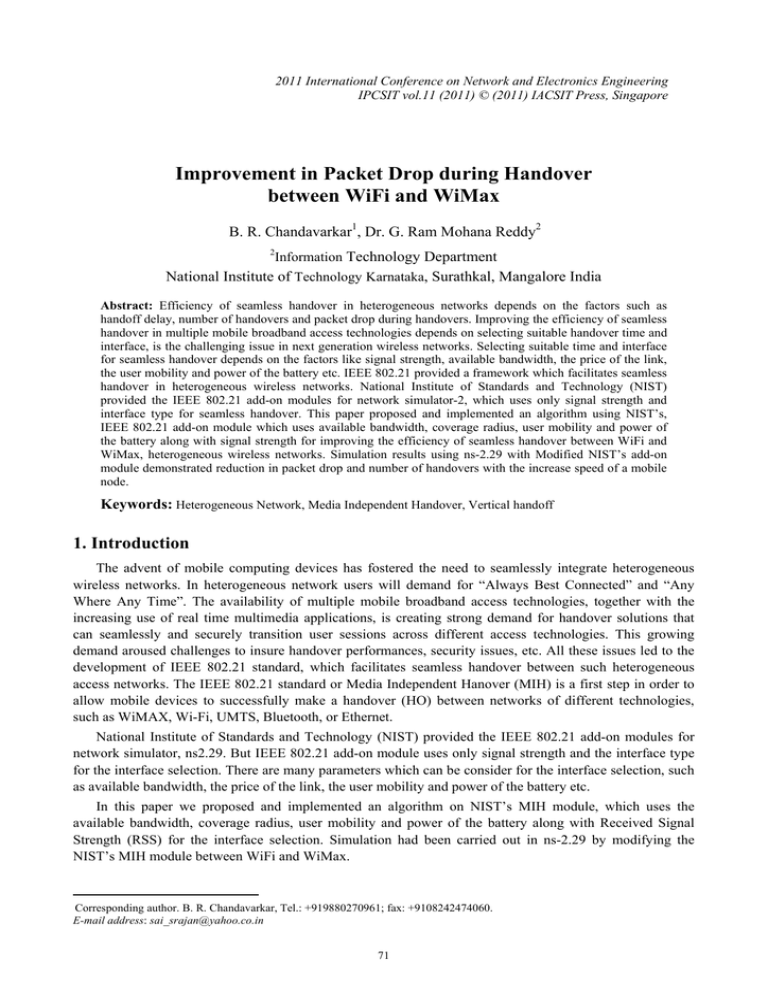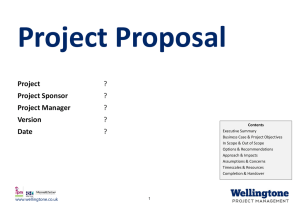Improvement in Packet Drop during Handover between WiFi and WiMax
advertisement

2011 International Conference on Network and Electronics Engineering IPCSIT vol.11 (2011) © (2011) IACSIT Press, Singapore Improvement in Packet Drop during Handover between WiFi and WiMax B. R. Chandavarkar1, Dr. G. Ram Mohana Reddy2 2 Information Technology Department National Institute of Technology Karnataka, Surathkal, Mangalore India Abstract: Efficiency of seamless handover in heterogeneous networks depends on the factors such as handoff delay, number of handovers and packet drop during handovers. Improving the efficiency of seamless handover in multiple mobile broadband access technologies depends on selecting suitable handover time and interface, is the challenging issue in next generation wireless networks. Selecting suitable time and interface for seamless handover depends on the factors like signal strength, available bandwidth, the price of the link, the user mobility and power of the battery etc. IEEE 802.21 provided a framework which facilitates seamless handover in heterogeneous wireless networks. National Institute of Standards and Technology (NIST) provided the IEEE 802.21 add-on modules for network simulator-2, which uses only signal strength and interface type for seamless handover. This paper proposed and implemented an algorithm using NIST’s, IEEE 802.21 add-on module which uses available bandwidth, coverage radius, user mobility and power of the battery along with signal strength for improving the efficiency of seamless handover between WiFi and WiMax, heterogeneous wireless networks. Simulation results using ns-2.29 with Modified NIST’s add-on module demonstrated reduction in packet drop and number of handovers with the increase speed of a mobile node. Keywords: Heterogeneous Network, Media Independent Handover, Vertical handoff 1. Introduction The advent of mobile computing devices has fostered the need to seamlessly integrate heterogeneous wireless networks. In heterogeneous network users will demand for “Always Best Connected” and “Any Where Any Time”. The availability of multiple mobile broadband access technologies, together with the increasing use of real time multimedia applications, is creating strong demand for handover solutions that can seamlessly and securely transition user sessions across different access technologies. This growing demand aroused challenges to insure handover performances, security issues, etc. All these issues led to the development of IEEE 802.21 standard, which facilitates seamless handover between such heterogeneous access networks. The IEEE 802.21 standard or Media Independent Hanover (MIH) is a first step in order to allow mobile devices to successfully make a handover (HO) between networks of different technologies, such as WiMAX, Wi-Fi, UMTS, Bluetooth, or Ethernet. National Institute of Standards and Technology (NIST) provided the IEEE 802.21 add-on modules for network simulator, ns2.29. But IEEE 802.21 add-on module uses only signal strength and the interface type for the interface selection. There are many parameters which can be consider for the interface selection, such as available bandwidth, the price of the link, the user mobility and power of the battery etc. In this paper we proposed and implemented an algorithm on NIST’s MIH module, which uses the available bandwidth, coverage radius, user mobility and power of the battery along with Received Signal Strength (RSS) for the interface selection. Simulation had been carried out in ns-2.29 by modifying the NIST’s MIH module between WiFi and WiMax. Corresponding author. B. R. Chandavarkar, Tel.: +919880270961; fax: +9108242474060. E-mail address: sai_srajan@yahoo.co.in 71 The rest of paper is organized as follows: Section 2 presents related work, Section 3 presents Overview of NIST’s MIH module, Section 4 presents parameters related to better interface selection, Section 5 presents an algorithm for interface selection and Section 6 presents results and analysis. 2. Related Work Kenichi Taniuchi et. al. [4] has introduced the different features, uses and the facts of IEEE 802.21 standard Media Independent Handover (MIH). Mostafa Zaman Chowdhury et. al. [1] proposed the solution for Interface Selection for a multiple interface node based on priority in heterogeneous networks. Hugo Marques et. al. [2] described 802.21, its implementation in ns-2 and signaling used during handover between WiFi and WiMax. Simulation carried out uses only basic functionalities of NIST’s MIH module. Pyung-Soo Kim et. al. [8] proposed the new fast vertical handover scheme for the hierarchical Mobile IPv6, called the FVH-HMIPv6, to optimize and enhance the existing scheme in heterogeneous wireless access networks 3. NIST’s MIH module for ns2 Depending network type involved handover can be of two types, Horizontal and Vertical handover. Handover within same access technology (WiFi <-> WiFi) is horizontal and within the different access technology (WiFi <-> WiMAX) is vertical handover [5][6]. Longer the handover duration, higher the packet drop and poor QoS [7]. IEEE with 802.21 MIH addressed vertical handover, which isolates the different access technology in a mobile device from the upper layers in the protocol stack. NIST provided the 802.21 MIH add-on modules [3] for network simulator (ns2.29). These modules support the two of the MIH functions, event and command. 3.1 802.21 Supported Technologies in ns-2 Currently ns-2.29 supports the following access technologies in IEEE 802.21 scenarios: WiMAX (802.16), Wi-Fi (802.11), UMTS and Ethernet (802.3). 3.2 Implementation of Nodes with Multiple Interfaces in ns-2 NS-2 does not support the heterogeneous multiple interfaces of a mobile node (MN), because external packages do not necessarily follow the same node structure as the one defined in the basic model. To resolve this issue, NIST created the concept of multiface node, which is a node who links to other nodes, which are interfaces for the multiface node, and the multiface node can be viewed as a “supernode”. This concept is illustrated in Fig. 3.1. Fig. 3.1: High Level View of MultiFace Node Fig. 3.2: Power boundaries defined in NS2 The interface nodes trigger events and send them to the multiFace node. The MIH Users on the multiFace node can register to receive these events. 3.3 Power Boundaries in WiFi and WiMAX Cells in ns-2 In order to identify power boundaries to be used in the simulation, three variables are used in ns-2, which is shown in Fig. 3.2. Theses variable can be defined as: • ‘CSTresh’ defines the minimum power level to sense wireless packets and switch the MAC from idle to busy. 72 • • ‘RX Tresh’ defines the minimum power level to receive wireless packets without error; ‘pr_limit’ is always equal or superior to 1 and is used in the equation (RX Tresh) * (pr_limit), this equation defines the minimum power level that an interface senses before triggering a Link Going Down event. 3.4 Handover Algorithm IEEE 802.21 module uses the make-before-break (MBB) algorithm for the seamless handover. In this algorithm mobile node connect with new network before terminating its previous network. By using the MBB algorithm mobile node will use both interfaces at the same time in order to perform a seamless handover. 4. Selected Parameters for the better Interface Selection IEEE 802.21 add-on modules uses only signal strength and the interface type for the interface selection. The proposed and implemented algorithm uses the available bandwidth, coverage radius, user mobility and power of the battery along with RSS for the interface selection. 4.1 Available Bandwidth Bandwidths provided by different versions of WiMAX and WiFi networks are different. IEEE 802.16d – 75Mbps, 802.16e – 30Mbps and 802.11a – 54Mbps, 802.11b – 11Mbps, 802.11g – 54 Mbps. Available bandwidth of an access technology decides the data transfer rate. Lesser the available bandwidth higher the load and it is not advisable to handover to such a network. 4.2 Coverage Radius and User Mobility Coverage radius of Access Point (AP) and user mobility are the another parameters to reduces the unnecessary handover. Lower the coverage radius of the AP and higher the speed of the mobile node, it is better to use its previous network without the handover. Every AP periodically broadcast the beacon message to inform the mobile node about its presence. In our implementation, we modified the beacon packet by adding variable coverage_radius. The coverage_radius store the radius (R) of the AP’s coverage area. AP estimate the coverage radius based on the transmit power of the beacon message. MN can enter the coverage area of the AP from any point and if the MN moves in straight line the total distance travel by mobile node in the coverage area of the access point is equal to chord “C”. Value of the ‘C’ will be different for different scenario [9]. C = 4XR/∏ Estimated Time [ET] = C / Speed T = C1.Th + C2.RT + C3 When the mobile node receives the beacon message it calculates the expected time “ET”, i.e ration of average chord to speed of MN, that it will stay in the new an AP. If “ET” is less than threshold time T, MN will avoid the handover. Where, “Th” is the handover delay, “RT” is the traffic rate and C1, C2 and C3 are the positive constant whose value are dependent on the type of the application, traffic rate of mobile node. 4.3 Battery Power of the mobile node Access of different networks causes the different level of the battery power consumption, due to difference in energy required for transmitting and receiving the packets. The battery power consumption for the WiFi interface is more than the power that of WiBro (mobile WiMAX) interface. MN can be in normal mode or power saving mode. If the MN is in power saving mode there is no handover from WiMAX to WiFi because of battery power consumption for WiFi is more than WiMAX interface and to avoid power loss during handover. 5. Proposed Algorithm for Interface Selection Fig. 5.1 shows the WiMAX to WiFi (a) and WiFi to WiFi (b) handover decision flowchart which considers battery life, speed of MN and Coverage area of access point. WiFi to WiMAX handover trigger when the MN is moving away from the coverage area of the WiFi. 73 (a) WiFi <-> WiMAX (b) WiFi <-> WiFi Fig. 5.1 Interface selection between WiFi <-> WiMAX & WiFi <-> WiFi 6. Result and Analysis Simulation has been carrier out using NIST’s available MIH module and modified MIH module for the scenario shown in Fig. 6.1 for different coverage area, speed of mobile node and different bandwidth for WiFi and WiMAX. Comparison results in Table 1 show the improvement in packet drop with Modified NIST module. Maximum possible Hanover is = 2*(Σ api), where api, denotes the ith AP for which ET > T. Fig. 6.1: Simulation scenario Fig. 6.2: Result Analysis Table 1: Number of packet drops with NIST & Modified NIST Module 74 7. Conclusions To access multiple access networks multiple choices of interfaces are good opportunities with the suitable price and better services level as required. The main problem with the multiple interfaces operated MN is difficulties in the selection of best interface. In this paper, we proposed interface selection based on coverage area, available bandwidth and power consumption of the mobile node. The battery power level has also been considered as the interface selection parameter for the interface selection algorithm. Thus, for lower battery level environment, the MN will operate in the power saving mode to select the low power consuming interface. The proposed architecture for interface selection can provide a good handover decision for overlaying network. The numerical results show that the proposed algorithm is capable to select appropriate interface in both the normal operating mode and power saving mode. 8. Acknowledgments Our sincere thanks to Mr. Santosh Kumar and Mr. Navin Kochar, CSE Department, NITK, Surathkal, who supported in implementing Modified NIST on ns-2.29. 9. References [1] Mostafa Zaman Chowdhury and Yeong Min Jang, “Priority based Interface Selection for Overlaying Heterogeneous Networks,” Department of Electronics Engineering, Kookmin University, Seoul 136-702, Korea, 2011 [2] HugoMarques, Jos´e Ribeiro, PauloMarques,and Jonathan Rodriguez. “Simulation of 802.21 Handovers Using ns2, ” Instituto Polit´ecnico Castelo Branco, Escola Superior de Tecnologia, Avenida do Empres´ario, 6000-767 Castelo Branco, Portugal, Instituto de Telecomunicac¸˜oes, Universidade de Aveiro, Campus de Santiago, 3810193 Aveiro, Portugal. June 2010 [3] “The network simulator NS-2 NIST add-on”, IEEE 802.21model, NIST, January 2007. [4] .Kenichi Taniuchi, “IEEE 802.21: Media Independent Handover: Features, Applicability and Realization”, Toshiba America Research Inc. 2009 [5] Ashutosh Datta, Subir Das, David Famolari, “Seamless Handover across Heterogeneous Networks”, Telcordia Technologies, NJ, 2007 [6] Hossen Mahmod Altwelib, Dr . Majdi Ali Ashibani, “Vertical Handover Scheme for Next Generation Mobile Networks,” University of AL-Mergib Faculty of Engineering Electrical and a Computer Department Communication Division, May, 2007 [7] Wankawee Puangkor, Panita Pongpaibool, “A Survey of Techniques for Reducing Handover Latency and Packet Loss in Mobile IPv6,” Universite Claude Bernard Lyon 1, FRANCE, National Electronics and Computer Technology Center, THAILAND, 6 Mar 2006 [8] Pyung-Soo Kim, and Yong Jin Kim, “ Hierarchical Mobile IPv6 Based Fast Vertical Handover using IEEE 802.21 Media Independent Handover Function,” Department of Electronics Engineering, Korea Polytechnic University, Siheung-City, Kyonggi- Do, 429-793, Korea, 2007 [9] W.J.M. de Kruijf*, J.L. Kloosterman,“On the average chord length in reactor physics,” Interfaculty Reactor Institute, Delft University of Technology, Mekelweg 15,2629 JBDelft, The Netherlands, September 2002. 75






